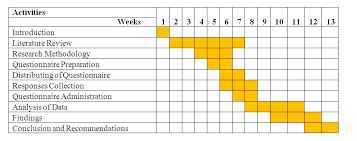“The differences in communication styles between men and women have been a topic of interest in the research world for many years. These differences may lead to miscommunication, conflict, and even dissatisfaction between couples. This study analyzes the communication styles among genders, more specifically among married couples. It questions how differences in communication styles between married couples married five years or less affect marital satisfaction. …”
How to Write a Great Thesis Proposal The Easy Way

A thesis proposal is the link-bridge to the main thesis, laying out the plan of how you will conduct the research. This way, the professors (assessment committee) will know that you are on the right path and got the right tools to get to the final destination.
The first step is developing a thesis proposal outline, commonly referred to as a thesis proposal template, which will help you do your project. It provides a clear thesis proposal format so that you can easily know what to do at what stage. Your proposal should be structured on a number of key elements, each of which should assist you to define the main project.
Thesis Proposal Template
- Abstract. This is a summary of the entire proposal.
- Define the topic of the proposal. The topic is the title of the project and gives the reader a general idea of what the thesis is all about.
- Write the introduction. The introduction helps to bring out the main issues in the thesis as well as its significance.
- Craft your research questions. These are the questions that you will be seeking to answer in the thesis.
- Review the related literature. This is a comprehensive analysis of existing literature on the topic you are working on.
- Methods. These are the theoretical approaches and methods that will be used to do the study.
- Timeline. In this part, you outline the time required for doing your study.
- Conclusion. This is the last part of your proposal and is used to give the anticipated results from the study.
How to Write a Thesis Proposal
A thesis proposal requires comprehensive research, preparation, and a well-defined final destination. Here is a step-by-step guide to help you craft thee best proposal for your thesis.
This is a brief summary of the entire proposal. We recommend that you do the abstract as the last item after completing the proposal. A single paragraph should be okay for your abstract. See a sample abstract in the paragraph below:
“The differences in communication styles between men and women have been a topic of interest in the research world for many years. These differences may lead to miscommunication, conflict, and even dissatisfaction between couples. This study analyzes the communication styles among genders, more specifically among married couples. It questions how differences in communication styles between married couples married five years or less affect marital satisfaction. …”
This is the first and the most important step in writing your proposal for a thesis. When selecting a topic, consider starting broadly and narrowing down to a specific area of interest. Furthermore, the topic should help to fill a gap in knowledge and be something that you can manage and write about.
Discuss the topic with your supervisor. Your supervisor can help you to refine the topic further, and give you the assurance that you are headed in the right direction. He/she will also assist you in grasping the complexities to anticipate along the way and the best way to approach them. See a good thesis proposal example topic.
“A Detailed History of Halloween and King of Gourds: A Study of Horror Symbolism”
The introduction is one of the first parts of the thesis, which helps to grab the interest of the readers and bring out the purpose of the study. Here, you explain the background of the topic, relevance of research, and the thesis statement. Note that you need to cite sources appropriately along the way. See an example introduction for a thesis proposal.
“The first spooky faces were carved on pumpkins by rats, although considered inferior, mimics were later done by people. When rats brought the dangerous Black Death, people started connecting pumpkins to plague. Pumpkins were also used to scare off the spirits of the dead person to prevent further deaths. Soon after, Jack o lanterns were adopted across the globe as common Halloween talismans.”
These are the main questions that you will be seeking to answer with the thesis. The questions should offer more focus and direction about the study you are proposing, and make the roadmap towards the targeted results. You might want to practice by learning how to write a thesis proposal sample. See the examples of thesis research questions:
“What effect does daily use of Facebook have on the Attention span of adolescents?”
“What effect do legal approaches have on people who drink and drive in the UK?”
A literature review is a concise analysis of the sources that one intends to use during research. Note that it goes deeper into looking at the significance of the resources and helps to demonstrate your current knowledge base on the topic. Here is a thesis proposal sample literature review paragraph.
“Noller (1980) comprehensively compared the effectiveness of women and men as nonverbal communicators. Being an effective communicator involves both encoding and decoding messages. Noller argued that women have a natural tendency to be more expressive. He added that men tend to make more errors than women when encoding messages.”
The methodology is another crucial element of a thesis proposal, which involves analyzing the theoretical approaches and methods that will be used to do the study. Here, you need to highlight the initial data that you might have collected and the expected implications of the findings. Here are the things you can discuss in this section.
Here is a sample methodology paragraph in a thesis proposal.
“To analyze the mytho-perceptions on use of pumpkins in history, as brought out in different works of literature, textual criticism within a Marxist deconstructionist framework will be used. To further analyze the rat-pumpkin relationship, the Freudian approach will be employed.”
A good proposal should have a clear timeline. This is a breakdown of the time that each stage of the study will require. Your evaluation committee will use the timeframe to gauge the feasibility of the study. See a sample timeline for a thesis:

The conclusion is the last part of your proposal. Here, you explain the anticipated results from the studies, especially the contributions to the knowledge base. See the example of a sample conclusion for a proposal below:
“
Seek Thesis Proposal Help
At this point, it is important to point out that writing a thesis proposal is never easy. Indeed, many are university students who get stuck even before getting started. But you cannot give up because the proposal is the gateway to crafting a great thesis. Therefore, you should seek writing help from professionals.
The experts have been writing thesis proposals and other tasks that students fund tough to handle. In addition to being experts in different fields, they know what works and what does not. So, they are your best bet to crafting a great proposal and, finally, the best thesis to impress the evaluation committee.
Thesis Proposal FAQ
Although the length of a thesis proposal may differ from one university to another, the average length is about ten pages.
Well, there is no standard formatting and citation method when it comes to writing proposals and thesis. However, your department will give the recommended formatting and citation style that students should use for their proposal.
If your department does not provide a clear guideline on formatting and citation, consider checking the best sample thesis proposal to see how the best students did it.
“The first spooky faces were carved on pumpkins by rats, although considered inferior, mimics were later done by people. When rats brought the dangerous Black Death, people started connecting pumpkins to plague. Pumpkins were also used to scare off the spirits of the dead person to prevent further deaths. Soon after, Jack o lanterns were adopted across the globe as common Halloween talismans.”The methodology is a description of the methods you will be using in the paper to answer your key questions. This could include theoretical approaches, analytical frameworks, philosophies, formulas, equations, or experiments.Share
Before you write your thesis, you'll probably have to write a thesis proposal. But what is a thesis proposal? Think of it as the roadmap. The thesis proposal lays out how you're going to get from point A, an unformed idea, to point B, a thoroughly researched and comprehensive exploration of that idea.
What's more, you're going to have to submit this roadmap to your professors, advisors, and/or a committee. They will evaluate it to make sure that you know where you're going, that you have the correct route marked out, and that you have all the tools you need to get there. Further, they'll determine whether this is the right journey to take, as they don't want to send out a search party if you end up lost in the dunes of an intellectual desert.
So your map had better be good. (No pressure!)
Your thesis proposal will require research, preparation, and a clear vision of your final destination. A thesis proposal is typically structured around a number of common sections, each of which will help you lay out the plans for your project. We'll look at each section in turn.
Title Page
The title page contains basic identifying information (the author's name, mentor's name, institution department, date, etc.), and a descriptive title for the thesis that helps describe the proposed project.
As Halloween is fast approaching, let's use the following example topic to demonstrate each aspect of a thesis proposal:
Abstract
The abstract provides a brief summary (typically fewer than 200 words) of your proposed thesis. It should generally provide an introduction to the topic (a brief history of pumpkins and jack o' lanterns), the key statement of the paper (Halloween would cease to exist without the pumpkin), how you will address the issue (an exploration of pumpkins in history and literature), and the implications of your work if completed successfully (a reinvigoration of pumpkinology).
Table of Contents
The table of contents should list all the headings and subheadings for your thesis proposal, providing page numbers for each to ensure swift navigation through the proposal.
Introduction
The introduction sets the context of your thesis and must capture your reader's interest. This is where you explain the background of your topic and the relevant research, starting from a broad perspective and then narrowing down to your thesis statement, citing sources along the way.
- Spooky faces were first carved into pumpkins by rats (who were living in these scooped-out gourds), though inferior imitations were later produced by humans. After rats brought the Black Death, plague fears were connected with pumpkins, which were used to ward off spirits of the newly deceased in an attempt to control fears of illness, death, and the apocalypse. Jack o' lanterns soon became common Halloween talismans throughout the world.
Key Questions
These are the main questions you are trying to answer in your thesis. The questions should provide a focus and direction for the proposed study, guiding you toward your intended results.
Literature Review
A literature review includes a brief but precise explanation of the sources you intend to use in your research. It outlines their significance and indicates your current knowledge base and your future goals in terms of the research, if relevant.
- The Pumpkin King (Skellington et al., 2006) explores the monarchy's longstanding relationship with pumpkins and provides a vital link between rat plagues, horror symbolism, and the politicization of the pumpkin.
Methodology
The methodology is a description of the methods you will be using in the paper to answer your key questions. This could include theoretical approaches, analytical frameworks, philosophies, formulas, equations, or experiments.
- Textual criticism within a Marxist, feminist, and deconstructionist framework will be used to analyze the mytho-perception of pumpkins throughout human history, as evidenced in various works of world literature, with a Freudian approach adopted for an analysis of the rat&ndash
Conclusion
This is where you explain the expected results of your research, its possible contributions to the field, and the methods that will be used to ensure validity and accuracy. This is usually followed by a thesis proposal summary, which restates and specifies the goals of the study.
- Pumpkins are a vital Jungian symbol of the subconscious mind's desire to transform and control feelings of fear and horror and of the human need to know the unknowable. The field of pumpkinology will be greatly expanded by this study, and fellowship with rats will be supported and expanded, heralding a new age of plague-free companionship.
Bibliography
This is a reference list of all works used in the writing of the thesis proposal, following the particular style guide requested.
- Skellington, J., Burton, T., King, S., and Hawthorne, N. (2011). Nightmares and dreamscapes: Pumpkins, rats, and symbols that go bump in the night. The Journal of Gourds and Rodentia, 47(2), p. 666.
And there you have it: a quick map to writing a thesis proposal! You have a big challenge ahead of you, but with a little planning and hard work, it can be done. Still uncertain of the process? Send your thesis proposal or dissertation to the editors at Scribendi for a thorough review.
The introduction sets the context of your thesis and must capture your reader's interest. This is where you explain the background of your topic and the relevant research, starting from a broad perspective and then narrowing down to your thesis statement, citing sources along the way. Thesis proposal is probably one of the most interesting and challenging tasks any student can face during college years. It is an assignment, which may greatly influence your future career and help to establish important connections. That is why every student needs to take it seriously and the best way is to learn how to write a thesis proposal before getting started.Dissertation proposal template and examples
If you want your proposal to be as interesting and precise as possible, you may probably need help of a dissertation proposal sample, which will help you highlight the strong and weak sides of your own paper. In order to eliminate all possible mistakes, you should also pay attention to the dissertation proposal example structure. It usually consists of following parts:
- Title
Following all the advices and tips will surely help you to provide an outstanding dissertation proposal with minimum efforts and stress.
100% Originality Assured. Only Qualified Specialists

